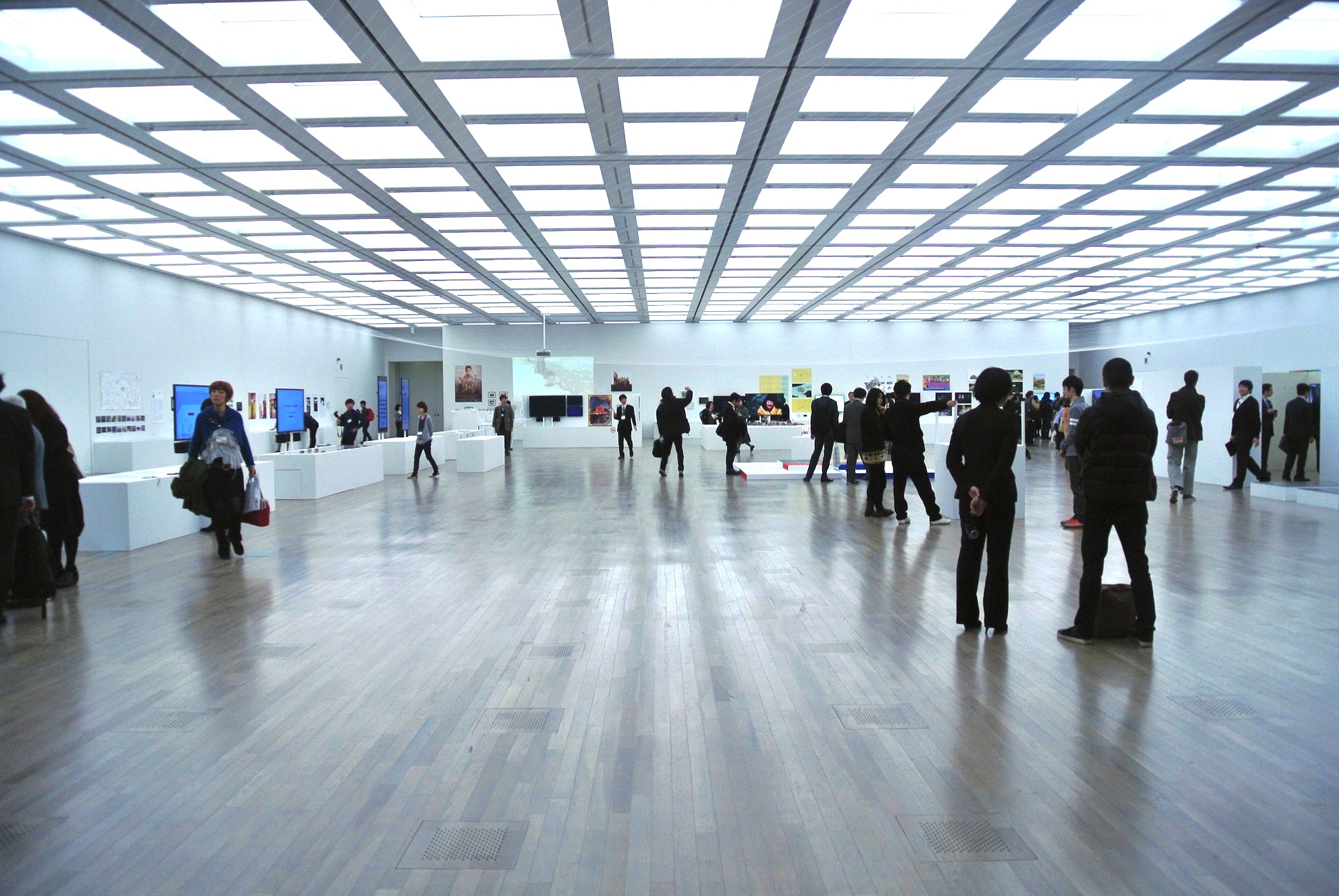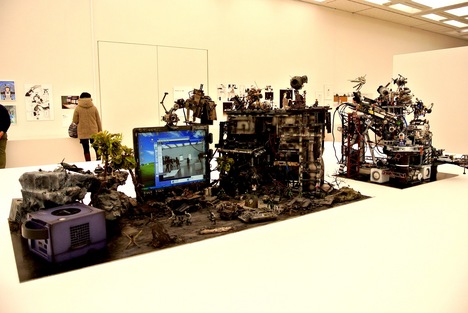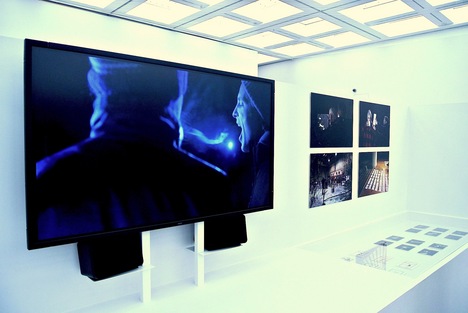THE 17TH JAPAN MEDIA ARTS FESTIVAL
A media arts festival with “current” art that connects memories and opens our eyes.

Passing the registration desk and walking through the entrance, an exhibition space without any partitions appears. The 17th Japan Media Arts Festival Exhibition of Award – Winning Works, Courtesy of Japan media Arts Festival Secretariat
The Japan Media Arts Festival, held this year for the 17th time since it began in 1997, received more submissions than it has in the past with 4,347 works from 84 countries (and regions). Art, Entertainment, Animation, and Manga are the four divisions that are awarded a Grand Prize, Excellence Awards, New Face Awards, and Jury Selections. The festival also organized exhibitions, screenings, and talks at four venues including Tokyo Midtown, Cinem@rt Roppongi, and the National Art Center, Tokyo (the main venue).
Exhibition view of Carsten Nicolai’s “crt mgn” © 2013 Carsten Nicolai. All Rights reserved.
German artist Carsten Nicolai won the Grand Prize out of 2,482 entries in the Art Division. Inside the artist’s exhibition booth, from which a mysterious sound emanated, four neon pipes fastened to a wall illuminated two giant pendulums that swung back and forth. Directly beneath the swinging pendulums with magnetic ends were TV monitors. The screens – facing the ceiling – showed the neon pipes on the walls, and every time the pendulums swung above them, the images on the monitors became distorted as if ripples spread through them. Next to the monitors were antennas that read electromagnetic waves and converted them into sound. As the images on the screen waivered, the electromagnetic waves were translated into audible “sound” that could be heard by visitors. An introspective piece, this work makes visualizing energy – which cannot be seen or heard – possible.
Shuya Abe’s exhibition
This piece was created as an homage to the video art pioneer Nam June Paik when Nicolai held a solo exhibition at Tokyo’s Watari Museum of Contemporary Art, the year after Paik’s death. Perhaps it is no surprise that Nicolai, whose comprehensive art transcends genres and straddles the visual arts and experimental music, and who shows his work at museums and international exhibitions around the world, won the Grand Prize. However, it can be said that this work is a masterpiece that inherits and passes on the history of media art. “I first met Paik at an opening in New York. At the time, I wasn’t very familiar with his earlier works, but similar to what synthesizers did to the music scene, he created a groundbreaking world with video synthesizers,” shared the artist at the event “Perceiving the world through art – Making the world sentient through art.”
Across from Nicolai’s booth was a display by one of the Special Achievement Award winners Shuya Abe, who has collaborated with Paik on several projects as his engineer.
Exhibition view of Soichiro Mihara’s “the blank to overcome” © 2013 Soichiro Mihara All rights reserved.
Soichiro Mihara, whose media art utilizes systems with audio elements at its core, won one of the Excellence Awards in the Art Division for “the blank to overcome,” a part of the “blank” project the artist started in 2011. A small room was created in the exhibition space where foam overflowed from Mihara’s work. At times, the foam grew larger than a person, with bubbles forming and disappearing, continuously transforming without stopping. This piece, arising from the trauma of March 11, 2011 expresses the “hollowness” of losing something, the unstable and fluctuating “blankness” of loss through the use of “bubbles.” It expresses the artist’s wish to draw out emotions and discussions as an open inquiry into the state of society and unresolved events from each viewer who experiences the piece.
Exhibition view of Benedikt Gross’s “The Big Atlas of LA Pools” © Benedikt Gross, Joseph K LEE
Other Excellence Awards were given to “Dronestagram” (by James Bridle of the UK), a project that compiles images and locations bombed by drones, using only general media sources like the New York Times and Google Maps; and “The Big Atlas of LA Pools” (by Benedikt Gross of Germany), a project visualizing the over 43,000 swimming pools and artificial bodies of water in the Los Angeles area, mapped and enlarged, using big data made available as open source. Works that called for transparency of information and were critical of the overconfidence towards technology were selected as award winners.
Exhibition view of Ei Wada’s “Toki Ori Ori Nasu – Falling Records -” © 2013 Ei Wada
For the Art Division, a selection committee went through the submissions prior to the jury’s review of them, which was a new selection process the festival implemented this year. This procedure allowed each submission to be reviewed more carefully. There were many substantial works that did not win awards, but were selected by the jury. “Toki Ori Ori Nasu – Falling Records -” by Ei Wada was one such piece that garnered much attention. Transforming the old media style of open wheels, this series was exhibited as artwork that sought new values at ICC “Open Space 2013.” Open wheel tape recorders were placed above giant towering acrylic containers, and as the recorders played, the magnetic tapes fell into the containers below, creating a graphical pattern that grew as time progressed. When the tapes filled up their vessels, a symphony would start playing, cutting through the silence, and rewinding the tapes back into the open wheel recorders. The patterns created were erased, and the uncalculated folding of the tapes recommenced. Crowds gathered in front of this piece every time the sound of the symphony echoed through the exhibition space.

Dora Garcia: The Joycean Society. 2012 HD Video © Photo: Giovanni Pancino, Courtesy of Prince Pierre of Monaco Foundation
While it was not among the exhibited pieces, “The Joycean Society” by 2011 Venice Biennale Spanish Pavilion representative Dora García was also selected by the Jury. The video piece captures a group of people who have been reading James Joyce for over 30 years. From the first page till the last word, society members spend 11 years to read a book, and then return right back to the first word. For the members, does the “universe” only consist of the time spent in this room? Or perhaps the world exists for this room. If we look at this “room” as an analogy of our respective daily environments, we may understand that the Joycean Society’s meetings are not such a peculiar situation.
Exhibition view of “Sound of Honda / Ayrton Senna 1989” © Honda Moter Co., Ltd and its subsidiaries and affiliates.
The Grand Prize in the Entertainment Division went to “Sound of Honda / Ayrton Senna 1989.” For this grand installation project, a team of eight, including Kaoru Sugano of Japanese advertising and PR agency Dentsu and media artist Daito Manabe, began with the idea of recreating the sound of Senna’s engine based on driving data recorded by Honda engineers. At the venue’s exhibition booth, visitors could experience the sound of the world lap record set by Ayrton Senna in the trials of the 1989 F1 Japanese Grand Prix, along with LED lighting and a beautiful video.
Exhibition view of Hiroto Ikeuchi’s “Fantasy captured in plastic model, A Desk Diorama” © 2013 Hiroto Ikeuchi
Winner of one of the Excellence Awards in the Entertainment Division, Hiroto Ikeuchi’s “Fantasy captured in plastic model, A Desk Diorama” stood out among a plethora of video works and pieces introducing the process of such video works. Representing the personal computer as a structure that preserves individual memory, a computer became a fortress that protects memory and the mouse turned into a tank running freely and protecting the perimeters of the fortress. Turning daily gadgets into a diorama-like artwork, this piece – which incorporates the useful and the useless, preserving an electronic board and its wirings intact – highlights the possibilities of the intrinsic functions and characteristics of everyday objects.
Exhibition view of the band Travis’s music video “Moving” © 2013 Red Telephone Box
The gekimation piece “The Burning Buddha Man” (by Ujicha) and the Scottish band Travis’s music video Travis “Moving” (by Tom Wrigglesworth and Matt Robinson) were given Excellence Awards as well. Both pieces crafted their messages by combining analog techniques with existing technology. In the latter music video that eschewed computer graphics, members of the band assembled in a studio set at -1°C. In search of the sharpest visual, hundreds of different shots of their warm breath in the cold air were tested. The selected video was used on a projected screen for this animation work. The blurry white shadows blown in front of the members’ faces energetically ran, jumped, sang, and at times played with a light source as if it were a ball, embodying the introspective yet pop world of the song’s lyrics. “The projected animations were all simple and minimal, and yet they contributed to drawing out the richness in the act of breathing and changes in air circulation, “ commented jury member Yugo Nakamura.
Exhibition view of Minetaro Mochizuki / Original author: Shugoro Yamamoto’s “CHIISAKOBEE” © Minetaro Mochizuki / Shugoro Yamamoto 2013
Hirohiko Araki’s “JOJOLION – Jojo’s Bizarre Adventure Part 8 -” won the Grand Prize in the Manga Division. While manga by Japanese artists like Minetaro Mochizuki’s “CHIISAKOBEE” and Haruko Kumota’s “SYOWA GENROKU RAKUGO SHINJU” were among the Excellence Award winners, French artist Bastien Vive’s “Le Goût du Chlore (A Taste of Chlorine)” was among the New Face Award winners.

Left: “Dans Mes Yeux” (In My Eyes) original cover, Caserman, 2009, Right: “Le Goût du Chlore (A Taste of Chlorine)” by Bastien Vives © Bastien Vives / Casterman / Shogakukan-Shueisha Productions Co., Ltd. © Casterman, 2005, 2009 All rights reserved.
Vives has received a New Face Award at an international exhibition in his native France as well. The piece tells the story of a boy, who begins to swim regularly at a pool for scoliosis therapy, becoming drawn to a girl who swims at the same pool every Wednesday. The manga depicts the sense of floating and even the smell of chlorine water through minimal dialogue, by not drawing outlines in the aquatic scenes and with a distinctive touch. Published for the first time in Japan, it also includes “Dans Mey Yeux (In My Eyes)” which colorfully records the daily perspectives of “her” from “my” point of view. Vives, who creates unique and universal works based on his French background while incorporating aspects of Japanese manga and animation, is an artist with the potential to excel in different artistic fields.

From “WHILE THE CROW WEEPS” © 2013 sukimaki animation All Right Reserved.
Makiko Sukikara and Kohei Matsumura’s “WHILE THE CROW WEEPS” was selected for one of the New Face Awards in the Animation Division. The duo has worked together on works that portray life in the vast wilderness, such as “Walkin’ on Snow Grass.” The awarded piece avoids anthropomorphizing its subjects, and simply narrates the tension in the wild, the reality of death, and living in such conditions; but the piece conveys the uncontrollable urges towards survival as well as affection towards life.
Exhibition view of “WHILE THE CROW WEEPS”
Visitors could get a glimpse of the artists’ work process in the exhibition booth, which displayed torn pieces of Japanese washi paper painted with ink, mineral pigments used for the background, and transparent acetate film.
Exhibition view of “Approved For Adoption” by Jung, Laurent Boileau © Mosaïque Films – Artémis Productions – Panda Média – Nadasdy Film – France 3 Cinéma – 2012
The Grand Prize in the Animation Division was awarded to Jung and Laurent Boileau’s “Approved For Adoption,” a semi-autobiographical story based on Jung’s life. Perhaps it is not too well known in Japan, but children from the Korean Peninsula were adopted all over the world after the Korean War. The animated work quietly progresses, interweaving actual 8mm footage, photos from Jung’s childhood, and videos of him visiting his birthplace at the age of 44 for the first time since being adopted by a Belgian family. The audience could genuinely experience this rich story, told with subtlety and at times with humor, because the artists skillfully and carefully considered the piece, and also knew what to leave out of it.
Exhibition view of “Approved For Adoption” by Jung, Laurent Boileau © Mosaïque Films – Artémis Productions – Panda Média – Nadasdy Film – France 3 Cinéma – 2012
At the exhibition, photographs that recording the years Jung spent with his family were framed and hung on the walls, resembling the Henin (Jung’s family) living room. At the same time, the showcase beneath displayed heart-wrenching memories, including his adoption form filled out by his biological mother and a receipt from KLM Airlines from when he was actually adopted. The heartaches and joys Jung has experienced may seem very specific and special, but they most likely link to similar feelings existing in all of us. There is no single model for human relationships, and events that lead to pain are unavoidable. During an interview, Jung explained, “I would like to tell everyone that you are fine the way you are, and that your life is not behind you; it is in front of you.”
After the talk “Perceiving the world through art – Making the world sentient through art”
(from left to right) Aomi Okabe, Carsten Nicolai, Soichiro Hihara, and Shiro Takatani
As I explored the works in the four different categories, a key word in media art – “technology” – became invisible, because I was consumed by the “sentiments” expressed in each work. The use of existing videos and open source data was a noticeable trend seen in many of the submissions in this year’s festival, and which leads us back to reaffirm “individuality.”
Presenting a system that does not work without the physical body, one of the Art Division’s New Face Award winners Hochi Lau’s piece “Learn to be a Machine | DistantObject#1” is a critique of today’s environment and interactivity that does not require physical contact. By connecting memories, internalizing technology, and promoting awareness, media art as a constantly developing “current” art urges us to notice things or shifts our awareness by visualizing, providing audio and making transparent what we cannot see. In the balance between technology and humanity, how will media art assist us to be more aware? Moving forward, side-by-side, while facing the “here and now,” I look forward to the further development of media art.
The 17th Japan Media Arts Festival
Date: February 5th –16th, 2014
Opening hours: 10:00 – 18:00
Place: The National Art Center, Tokyo and other venues
Address: 7-22-2 Roppongi, Minato, Tokyo
TEL:+81 (0)3 5459 4755
https://j-mediaarts.jp
Text: Noriko Yamakoshi
Translation: Makiko Arima


















